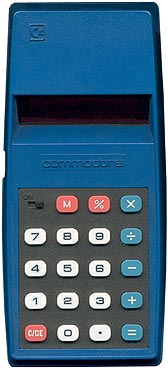
The Commodore 786D calculator was introduced in 1977. Manufactured by Commodore in both England and Japan, it was designed to be a cost-effective option in a highly competitive market. The 786D is a 4-function calculator that includes percentage calculations and multi-key memory functions, making it a practical tool for everyday calculations.
The Commodore 786D is notable for its distinct design and variations in color schemes. The calculator was produced in three different versions, each featuring a red LED display capable of showing nine digits. The variations include:
- A blue case with red, white, and blue keys.
- A beige case with red, white, and blue keys.
- A gray case with red, white, and blue keys.
The beige models I’ve seen have an (EX) key instead of the (M) key. The blue version of the 786D may have been a commemorative “red, white, and blue” edition for the UK Silver Jubilee.

The calculator’s dimensions are approximately 65mm x 137mm x 24mm (width, height, depth), and it weighs about 78 grams without batteries. It is powered by a 9V DC PP3 size battery or an adapter (DC-620R or 505) through a socket on the left side. The case design features a softly stippled two-piece plastic case with a black smooth keyboard surround, and the display is heavily inset with a flat red plastic filter that provides a bright image but has a limited viewing angle.
Components and Construction
Components:
- Central Processing Unit (CPU): Commodore 3D-98MT 4876 (manufactured in week 48 of 1976), featuring a 22-pin DIL package with a 0.3-inch width, encased in black plastic.
- Display: An eight-digit bubble lens LED display unit.
Board Configuration:
- The keyboard serves a dual purpose as the main CPU board and is secured to the front of the calculator using three screws and three rivets.

Assembly and Disassembly:
- To disassemble the calculator, first remove the two screws located at the rear.
- Gently push the lugs into their recesses and carefully hinge the back cover off from the top.
Logic
- The (C/CE) button clears the last entry on the first press and clears the entire calculator on the second press.
- Overflow on number input is suppressed; typing a nine-digit number ignores the ninth digit.
- An overflow in calculations displays the result without a decimal point and eventually resets to zero after reaching 1079.
- Dividing by zero results in “00000000,” which can be recovered by dividing by 1.
- There is no constant function, but squares can be calculated using (3)(X)(=) to yield “9.”
- Memory usage requires two key presses: (=)(M) to store, (+)(M) or (-)(M) to accumulate or decrement, and (0)(=)(M) to clear.
- There is no indication of memory storage; users must remember the stored value.
- Negative numbers are indicated by a “-” sign in the immediate left digit, limiting the display to seven-digit negative numbers. However, calculations can continue without the minus sign.
- The percentage key simply divides by 100.
- No bugs have been identified in the calculator’s logic.

The later series of the 786D utilized the 3D-98MT circuit and was designed to support 9-digit displays. However, the connection enabling the first digit was intentionally severed, resulting in the absence of error indications or negative signs for 8-digit numbers. Instead of featuring a register-exchange key, this version includes a memory key. Interestingly, if the missing connection is reestablished, the 786D can be transformed into a fully functional 796M model.
The Commodore 786D calculator is a classic example of 1970s technology, offering basic arithmetic functions and memory capabilities in a compact and affordable package. Despite its limitations in logic and display, it remains a great example of the early days of personal computing.


